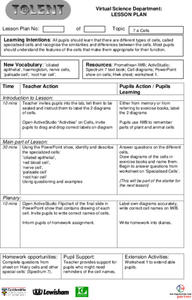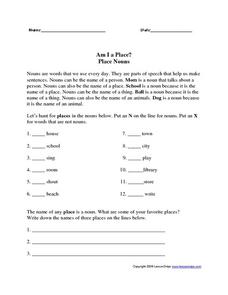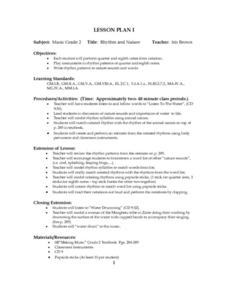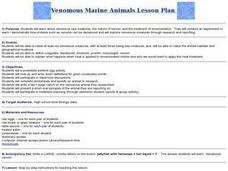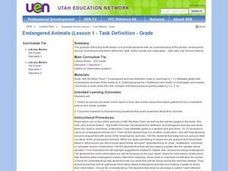Curated OER
Animals of Africa
Students identify animals indigenous to Africa, then create an imaginary animal using various materials they have at home. They write about their animal and include its name, characteristics, and describe how it defends itself.
Curated OER
Cells
Students explore the types of cells and their appropriate function. After observing a PowerPoint presentation, students draw diagrams of cells. Using a specified website, students identify parts of plant and animal cells. They answer...
Curated OER
Animals in Inspiration
Students research information on a specific animal. In this animal lesson, students use books to find information about an animals diet, habitat, appearance, and any other interesting facts. Students will use this information to create a...
Curated OER
Am I a Place?--Place Nouns
In this place nouns worksheet, students look over 12 words and put an N on the line before the word if it is a noun and an X if the word is not a noun. Students write down 3 of their favorite places to go.
Curated OER
Invertebrates and Vertebrate Evolution
Students explore the major characteristics of the major animal phyla. They describe adaptive features that have contributed to the success of animals on land. Students explain how primate evolution provides a context for understanding...
Curated OER
Rhythm and Nature
Second graders listen to song "Listen to the Water," discuss nature sounds and importance of water to life, perform quarter and eighth notes from notation, play instruments in rhythm patterns of quarter and eighth notes, and write rhythm...
Curated OER
Diamontes
Young scholars create a diamonte about bats. In this diamonte lesson, students review parts of speech and bat vocabulary. They take their vocabulary and plug it into a diamonte poem that compares bats with another animal using nouns,...
Curated OER
Zoo visitors look up to new baby
Young scholars, after playing a game of animal 'identity', review and practice key vocabulary words orally and written into their notebooks for this lesson. They read a story about a new arrival at the zoo and answer text questions...
Curated OER
ESL: Sea Animals Activity
In this ESL sea animals instructional activity, students watch a video about sea animals, then identify names of animals shown in pictures.
Curated OER
Farm Pictures
Students paint farm animals. In this farm animal lesson, students paint pictures of farm animals during one thirty minute session. They cut out and glue the pictures on a picture of a farm which they also painted in the second session.
Curated OER
Animal Body Coverings
First graders compare and contrast animals according to their various body coverings, (fur, scales, shells). Students discuss the different body coverings they have seen on animals. They conduct a sensory experiment in which they feel...
Curated OER
Animal Vocabulary Cards
Students practice a system that may help them understand more and remember more terms when they read. The reading of text is developed as a skill that second language learners need.
Alabama Learning Exchange
Animals as Pets: Everything You Need to Know
Learners complete internet based research on pet care in order to prepare a written and oral presentation for the class. They examine the life span, environment, food and grooming of the pet they chose to research. They complete the...
Curated OER
Personal Pronouns
In this personal pronouns worksheet, students read pronouns, check if sentences are right or wrong, choose the correct pronoun, and more. Students complete 4 activities.
Curated OER
Desert Discoveries
Learners correspond with Israeli students from Jerusalem by email as part of a study on desert and semi-arid regions. They conduct background research and become proficient in the use of electronic mail.
Curated OER
Ocean Life Zones Notes
In this ocean zones worksheet, students label the ocean diagram with the different zones. Then students write in animals that live in each of the zones and research basic information about those animals. This worksheet has 6 fill in the...
Curated OER
Venomous Marine Animals
Pupils name and describe six venomous marine animals. After participating in an activity, they define new vocabulary words. In groups, they complete worksheets to use while researching a specific venomous animal of their choice. They...
Curated OER
Understanding Science Vocabulary And Categorization
Young scholars explore and examine scientific language and categorization as related to commonly known plants and animals. They hypothesize about a specific plant or animal, how it was scientifically named, what concepts and vocabulary...
Curated OER
Louise, The Adventures of a Chicken
Students read the book Louise, The Adventures of a Chicken and do language arts activities based on the book. In this language arts lesson plan, students read the book given and do language arts activities that include taking a class pet...
Curated OER
Am I a Person?--People Nouns
In this nouns worksheet, students put a N next to each word in a list of 12 words if the word is a noun and an X if the word is not a noun. Students then write 3 people nouns on the lines provided.
Curated OER
Research PowerPoint Presentations
Second graders create a PowerPoint presentation about an animal they chose to research.
Curated OER
Adjectives
First graders participate in group activity in which they examine how to use words, adjectives, to better describe people, animals, places, and things. They listen to a read aloud of "The Napping House" while describing items on each...
Curated OER
A Journey with Belfield Along the Lewis and Clark Trail
Fourth graders make a PowerPoint presentation that includes a picture of a plant or animal, and the name that Lewis and Clark called each specific plant or animal. They make a personal journal entry written as Lewis and Clark may have...
Curated OER
Endangered Animals (Lesson 1 - Task Definition - Grade 3)
Third graders use The Big Six to gain an understanding of the phrase 'endangered animal.' They select an animal, research it and write a report about it. They also make a poster of the animal.

